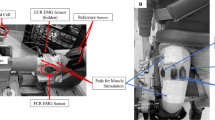Abstract
A method for non-invasive assessment of single motor unit (MU) properties from electromyographic (EMG), mechanomyographic (MMG) and force signals is proposed. The method is based on the detection and classification of single MU action potentials from interference multichannel surface EMG signals and on the spike-triggered average of the MMG (detected by an accelerometer) and force signals. The first dorsal interosseous (FDI) and abductor digiti minimi (ADM) muscles were investigated at contraction levels of 2% and 5% of the maximum voluntary contraction (MVC) force. A third contraction was performed by selective activation of a single MU with surface MU action potential visual feedback provided to the subject. At 5% MVC, the mean (±standard error) single MU MMG peak-to-peak value was 11.0±1.8 mm s−2 (N=17) and 32.3±6.5 mm s−2 (N=20) for the FDI and AMD muscles, respectively. The peak of the twitch force was, at the same contraction livel, 7.41±1.34 mN and 14.42±2.92 mN, for the FDI and ADM muscles, respectively. The peak-to-peak value of the MMG was significantly different for the same MU at different contraction levels, indicating a non-linear summation of the single MU contributions. For the FDI muscle, the MMG peak-to-peak value of individual MUs was 21.5±7.8 mm s−2, when such MUs were activated with visual feedback provided to the subject, whereas, for the same MUs, it was 11.8±3.8 mm s−2, when the subject maintained a constant force level of 2% MVC. The method proposed allows the non-invasive assessment of single MU membrane and contractile properties during voluntary contractions.
Similar content being viewed by others
References
Akataki, K., Mita, K., Watakabe, M., andIto, K. (2002): ‘Agerelated change in motor unit activation strategy in force production: a mechanomyographic investigation’,Muscle Nerve,4, pp. 505–512
Basmajian, J. V., andDeLuca, C. J. (1985): ‘Muscle alive’, (Williams & Wilkins, 1985)
Bigland-Ritchie, B., Johansson, R., Lippold, O. C., Smith, S., andWoods, J. J. (1983): ‘Changes in motoneurone firing rates during sustained maximal voluntary contractions’,J. Physiol.,340, pp. 335–346
Chan, K. M., Doherty, T. J., andBrown, W. F. (2001): ‘Contractile properties of human motor units in health, aging, and disease’,Muscle Nerve,9, pp. 1113–1133
Farina, D., Fortunato, E., andMerletti, R. (2000): ‘Non-invasive estimation of motor unit conduction velocity distribution using linear electrode arrays’,IEEE Trans. Biomed. Eng.,3, pp. 380–388
Farina, D., Gazzoni, M., andCamelia, F. (2004): ‘Low threshold motor unit membrane properties vary with contraction intensity during sustained activation with surface EMG visual feedback’,J. Appl. Physiol.,96, pp. 1505–1515
Gazzoni, M., Farina, D., andMerletti, R. (2004): ‘A new method for the extraction and classification of single motor unit action potentials from surface emg signals’,J. Neurosci. Methods,136, pp. 165–177
Kamen, G., andRoy, A. (2000): ‘Motor unit synchronization in young and elderly adults’,Eur. J. Appl. Physiol.,5, pp. 403–410
Laidlaw, D. H., Bilodeau, M., andEnoka, R. M. (2000): ‘Steadiness is reduced and motor unit discharge is more variable in old adults’,Muscle Nerve,4, pp. 600–612
Masuda, T., Miyano, H., andSadoyama, T. (1983): ‘The distribution of myoneural junctions in the biceps brachii investigated by surface electromyography’,Electroencephalogr. Clin. Neurophysiol.,6, pp. 597–603
Masuda, T., andSadoyama, T. (1986): ‘The propagation of single motor unit action potentials detected by a surface electrode array’,Electroencephalogr. Clin. Neurophysiol.,6, pp. 590–598
Merletti, R., Farina, D., andGranata, A. (1999): ‘Non-invasive assessment of motor unit properties with linear electrode arrays’,Electroencephalogr. Clin. Neurophysiol. Suppl.,50, pp. 293–300
Merletti, R., Farina, D., andGazzoni, M. (2003): ‘The linear electrode array: a useful tool with many applications’,J. Electromyogr. Kinesiol.,1, pp. 37–47
Orizio, C., Liberati, D., Locatelli, C., De Grandis, D., andVeicsteinas, A. (1996): ‘Surface mechanomyogram reflects muscle fibres twitches summation’,J. Biomech.,4, pp. 475–481
Orizio, C., Gobbo, M., Diemont, B., Esposito, F., andVeicsteinas, A. (2003): ‘The surface mechanomyogram as a tool to describe the influence of fatigue on biceps brachii motor unit activation strategy. Historical basis and novel evidence’,Eur. J. Appl. Physiol.,90, pp. 326–336.
Petitjean, M., andMaton, B., (1995): ‘Phonomyogram from single motor units during voluntary isometric contraction’,Eur. J. Appl. Physiol. Occupat. Physiol.,71, pp. 215–222
Sohn, M. K., Graven-Nielsen, T., Arendt-Nielsen, L., andSvensson, P. (2000): ‘Inhibition of motor unit firing during experimental muscle pain in humans’,Muscle Nerve,8, pp. 1219–1226
Yoshitake, Y., andMoritani, T. (1999): ‘The muscle sound properties of different muscle fiber types during voluntary and electrically induced contractions’,J. Electromyogr. Kinesiol.,3, pp. 209–217
Yoshitake, Y., Shinohara, M., Ue, H., andMoritani, T. (2002): ‘Characteristics of surface mechanomyogram are dependent on development of fusion of motor units in humans’,J. Appl. Physiol.,5, pp. 1744–1752
Zennaro, D., Laubli, T., andKrueger, H. (2003): ‘Motor unit identification in two neighboring recording positions of the human trapezius muscle during prolonged computer work’,Eur. J. Appl. Physiol.,6, pp. 526–535
Author information
Authors and Affiliations
Corresponding author
Rights and permissions
About this article
Cite this article
Cescon, C., Gazzoni, M., Gobbo, M. et al. Non-invasive assessment of single motor unit mechanomyographic response and twitch force by spike-triggered averaging. Med. Biol. Eng. Comput. 42, 496–501 (2004). https://doi.org/10.1007/BF02350990
Received:
Accepted:
Issue Date:
DOI: https://doi.org/10.1007/BF02350990




